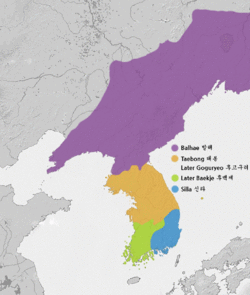Later Baekje
| Later Baekje | ||||||||||
| 후백제 (後百濟) | ||||||||||
| ||||||||||
 Later Baekje (in green) in 915. | ||||||||||
| Capital | Wansanju | |||||||||
| Languages | Korean | |||||||||
| Religion | Korean Buddhism, Korean Confucianism, Korean Taoism, Korean shamanism | |||||||||
| Government | Monarchy | |||||||||
| King | ||||||||||
| • | 892–935 | Gyeon Hwon (first) | ||||||||
| • | 935–936 | Singeom (last) | ||||||||
| History | ||||||||||
| • | Establishment | 892 | ||||||||
| • | Fall | 936 | ||||||||
| ||||||||||
| Today part of | | |||||||||
| Later Baekje | |
| Hangul | 후백제 |
|---|---|
| Hanja | 後百濟 |
| Revised Romanization | Hu-baekje |
| McCune–Reischauer | Hu-paekche |
Part of a series on the |
||||||||
|---|---|---|---|---|---|---|---|---|
| History of Korea | ||||||||
 | ||||||||
| Prehistory | ||||||||
| Ancient | ||||||||
| Proto–Three Kingdoms | ||||||||
| Three Kingdoms | ||||||||
|
||||||||
| North–South States | ||||||||
|
||||||||
| Later Three Kingdoms | ||||||||
|
||||||||
| Unitary dynastic period | ||||||||
|
||||||||
| Colonial period | ||||||||
|
||||||||
| Division of Korea | ||||||||
|
||||||||
| By topic | ||||||||
| Timeline | ||||||||
|
| ||||||||
Hubaekje or Later Baekje (Hangul: 후백제; Hanja: 後百濟; RR: Hubekje, Korean pronunciation: [huːbɛktɕ͈e]) was one of the Later Three Kingdoms of Korea, along with Hugoguryeo and Silla. It was officially founded by the disaffected Silla general Gyeon Hwon in 900, and fell to Wanggeon's Goryeo army in 936. Its capital was at Jeonju, in present-day North Jeolla province. Most of information now available about the kingdom comes from the accounts found in the Samguk Yusa and Samguk Sagi, which largely coincide.
Background
When it began with his attack on Mujinju in 892, Gyeon Hwon's was only one among numerous rebellions which sprouted up against the weak Silla rulers in late 9th century. Many of these rebellions were initially triggered by the Silla decision to use force to collect taxes on the peasantry in 889 (Lee, 1984, p. 98). At this time most of the power on the peninsula was held by local gentry, who lacked strong loyalty to the central government. It was thus fairly easy for rebellions led by disaffected military officials to gain steam.
In its name, Hubaekje sought to establish itself as the legitimate successor to the ancient kingdom of Baekje which had ruled the southwestern Korean peninsula until conquered by Silla in 660.
Internal affairs
For all but the last year of its existence, Hubaekje was ruled by Gyeon Hwon, and his personal style of rule played a key role in the kingdom's fate.
After declaring himself king, Gyeon Hwon took numerous wives, and is said to have had 10 sons by them in addition to the 8 borne by his first wife. This laid the groundwork for the strife which ended the kingdom's existence.
In 935, Gyeon Hwon chose his fourth son Geumgang over the elder sons as the crown prince of Hubaekje. At this the eldest son, Singeom, conspiring with his brothers, had his father confined to Geumsansa in Gimje. Singeom killed Prince Geumgang and took the throne for himself. However, Gyeon Hwon escaped to Goryeo.
Military affairs
For much of its existence, Hubaekje was troubled by Wanggeon's naval raids in Naju region. These worked to disrupt trade and diplomatic ties with Southern Chinese kingdoms.
Hubaekje possessed considerable military strength, and Lee (1984, p. 99) writes of Gyeon Hwon that "Had Gung Ye and Wang Geon not stood in his way, he surely would have had little difficulty in toppling Silla." Hubaekje showed its greatest strength in 927. In that year its armies attacked and pillaged the Silla capital at Gyeongju, slaying King Gyeongae and establishing King Gyeongsun as the ruler. Before the attack, Silla had sent for aid from Goryeo, and Wanggeon arrived with a large army shortly after Gyeongju was taken. The two armies met near Palgong Mountain in present-day Daegu. Wanggeon's forces in the battle reportedly numbered 10,000 men. Hubaekje triumphed, and Wanggeon himself only escaped through the daring self-sacrifice of his general Shin Sung-gyeom and Kim Nak.
However, when the two armies met again at the Battle of Gochang near Andong in 930, Goryeo scored a decisive victory. Hubaekje was pushed back into its heartland, and there suffered a further crippling defeat at Hongseong in 934.
Diplomatic ties
As Wanggeon sought to maintain legitimacy through diplomatic ties with northern China, Gyeon Hwon strove to do the same by maintaining ties with the rulers of southern China, particularly Wuyue. However, because Hubaekje's existence largely coincided with the turbulent Five Dynasties and Ten Kingdoms period in China, neither side was able to parlay these ties into military support.
Fall
After he was deposed by his sons in 935 and fled to Goryeo, Gyeon Hwon himself came to lead the armies against Hubaekje. Together with Wanggeon, the Samguk Yusa reports that he led an army of 100,000 against his former kingdom.[1] The Goryeo and Hubaekje armies met at Seonsan, today part of Gumi in North Gyeongsang province, and the Hubaekje forces were destroyed. Hubaekje thus finally fell in 936, one year after King Gyeongsun had surrendered Silla to Wanggeon. The battle of Seonsan thus marked the end of the Later Three Kingdoms period.
In his own characteristically open-handed style, Wanggeon conferred a title upon the defeated leader Singeom. Singeom's younger brothers Yanggeom and Yonggeom, who were judged to have been to blame for the coup d'etat, were sent into exile.
See also
Notes
References
- Lee, K. (1984). A new history of Korea. Trans. by E. W. Wagner & E. J. Schulz, based on Korean rev. ed. of 1976. Seoul: Ilchogak. ISBN 89-337-0204-0